2016 TOYOTA AURIS TOURING SPORTS trailer
[x] Cancel search: trailerPage 3 of 660
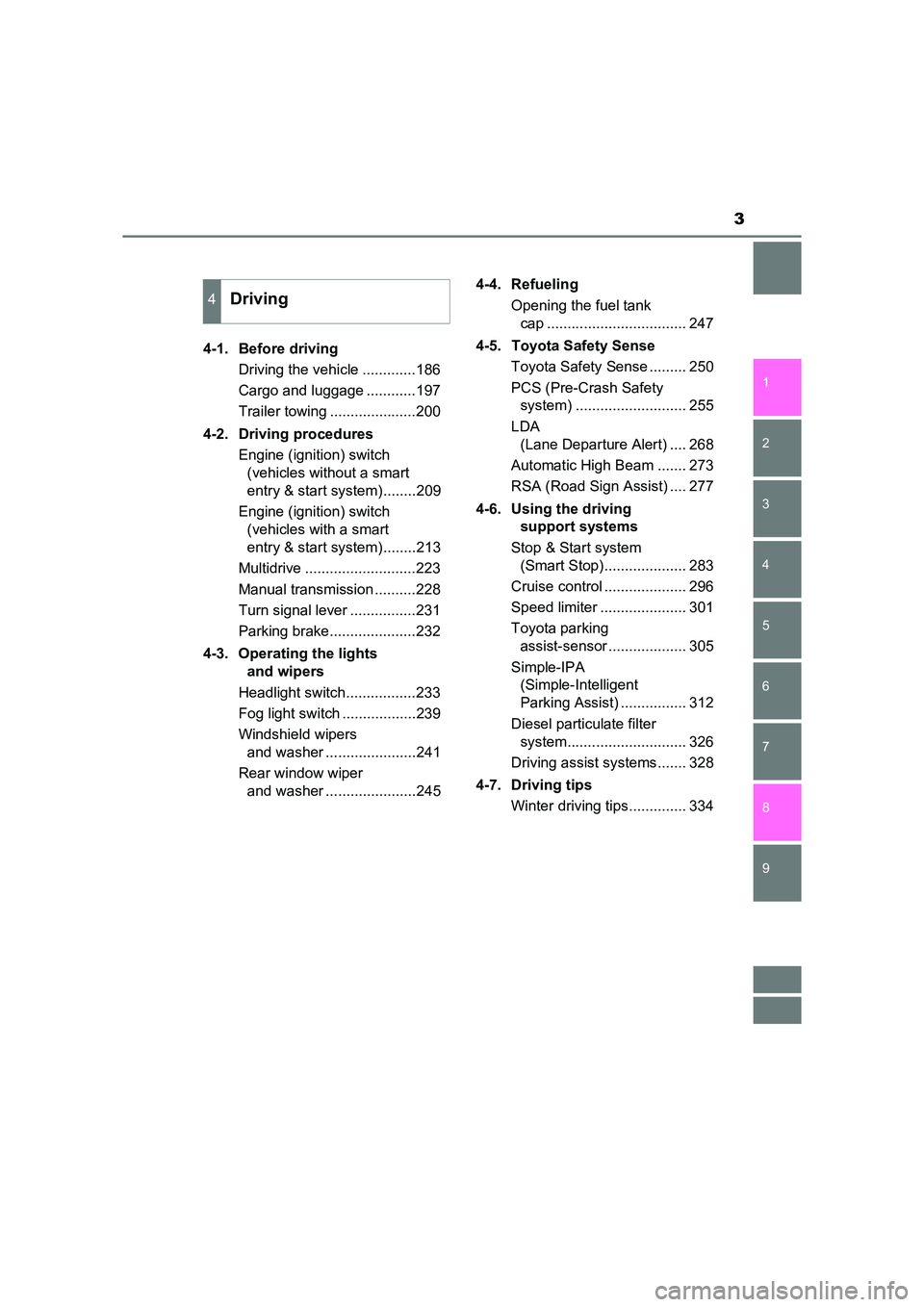
3
1
9 8
7 5 4
3
2
AURIS Touring Sports_EE (12K53E)
6
4-1. Before drivingDriving the vehicle .............186
Cargo and luggage ............197
Trailer towing .....................200
4-2. Driving procedures Engine (ignition) switch (vehicles without a smart
entry & start system)........209
Engine (ignition) switch (vehicles with a smart
entry & start system)........213
Multidrive ...........................223
Manual transmission ..........228
Turn signal lever ................231
Parking brake.....................232
4-3. Operating the lights and wipers
Headlight switch.................233
Fog light switch ..................239
Windshield wipers and washer ......................241
Rear window wiper and washer ......................245 4-4. Refueling
Opening the fuel tank cap .................................. 247
4-5. Toyota Safety Sense Toyota Safety Sense ......... 250
PCS (Pre-Crash Safety system) ........................... 255
LDA (Lane Departure Alert) .... 268
Automatic High Beam ....... 273
RSA (Road Sign Assist) .... 277
4-6. Using the driving support systems
Stop & Start system (Smart Stop).................... 283
Cruise control .................... 296
Speed limiter ..................... 301
Toyota parking assist-sensor ................... 305
Simple-IPA (Simple-Intelligent
Parking Assist) ................ 312
Diesel particulate filter system............................. 326
Driving assist systems....... 328
4-7. Driving tips Winter driving tips.............. 334
4Driving
Page 185 of 660
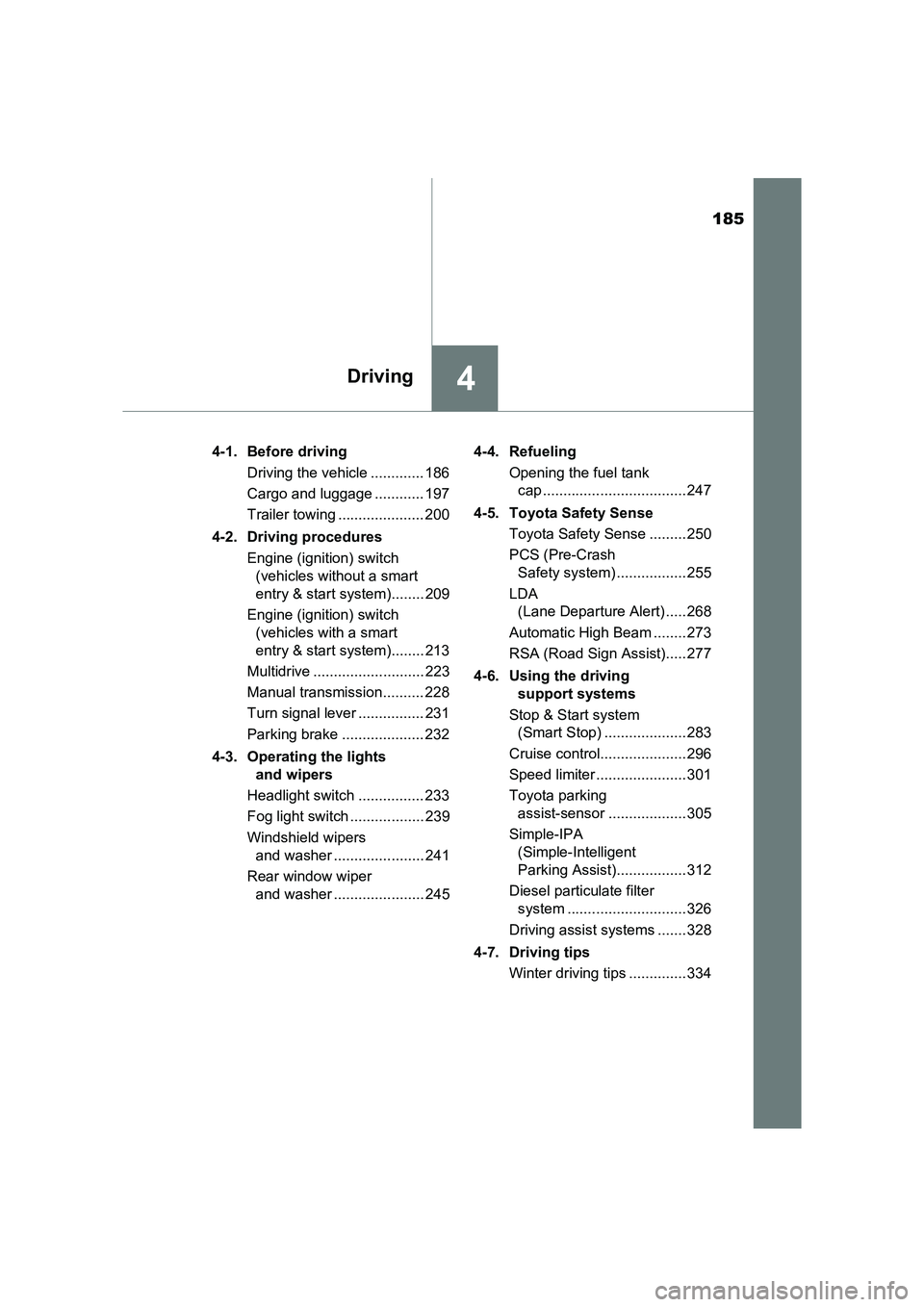
185
4Driving
AURIS Touring Sports_EE (12K53E)4-1. Before driving
Driving the vehicle ............. 186
Cargo and luggage ............ 197
Trailer towing ..................... 200
4-2. Driving procedures Engine (ignition) switch (vehicles without a smart
entry & start system)........ 209
Engine (ignition) switch (vehicles with a smart
entry & start system)........ 213
Multidrive ........................... 223
Manual transmission.......... 228
Turn signal lever ................ 231
Parking brake .................... 232
4-3. Operating the lights and wipers
Headlight switch ................ 233
Fog light switch .................. 239
Windshield wipers and washer ...................... 241
Rear window wiper and washer ...................... 245 4-4. Refueling
Opening the fuel tank cap ................................... 247
4-5. Toyota Safety Sense Toyota Safety Sense ......... 250
PCS (Pre-Crash Safety system) .................255
LDA (Lane Departure Alert) ..... 268
Automatic High Beam ........273
RSA (Road Sign Assist).....277
4-6. Using the driving support systems
Stop & Start system (Smart Stop) .................... 283
Cruise control..................... 296
Speed limiter ......................301
Toyota parking assist-sensor ................... 305
Simple-IPA (Simple-Intelligent
Parking Assist)................. 312
Diesel particulate filter system ............................. 326
Driving assist systems .......328
4-7. Driving tips Winter driving tips ..............334
Page 189 of 660

1894-1. Before driving
AURIS Touring Sports_EE (12K53E)
4
Driving
■Breaking in your new Toyota
To extend the life of the vehicle, observing the following precautions is recom-
mended:
●For the first 300 km (186 miles):
Avoid sudden stops.
● For the first 800 km (500 miles):
Do not tow a trailer.
● For the first 1000 km (621 miles):
• Do not drive at extremely high speeds.
• Avoid sudden acceleration.
• Do not drive continuously in low gears.
• Do not drive at a constant speed for extended periods.
■ Operating your vehicle in a foreign country
Comply with the relevant vehicle registration laws and confirm the availability
of the correct fuel. ( →P. 614)
■ Idling time before engine stop
To prevent damage to the turbocharger, allow the engine to idle immediately
after high-speed driving or hill climbing.
�X8NR-FTS engine
�X1ND-TV and 1WW engines
Driving conditionIdling time
Normal city driving Not necessary
High-speed driving Constant speed of approx.
100 km/h (62 mph) Approximately 1 minute
Steep hill driving or continuous driving at 100
km/h (62 mph) or more (race track driving etc.)
or towing a trailer Approximately
2 minutes
Driving conditionIdling time
Normal city driving Not necessary
High-speed driving Constant speed of approx.
80 km/h (50 mph)
Approximately
20 seconds
Constant speed of approx.
100 km/h (62 mph) Approximately 1 minute
Steep hill driving or continuous driving at 100
km/h (62 mph) or more (race track driving etc.) Approximately
2 minutes
Page 200 of 660
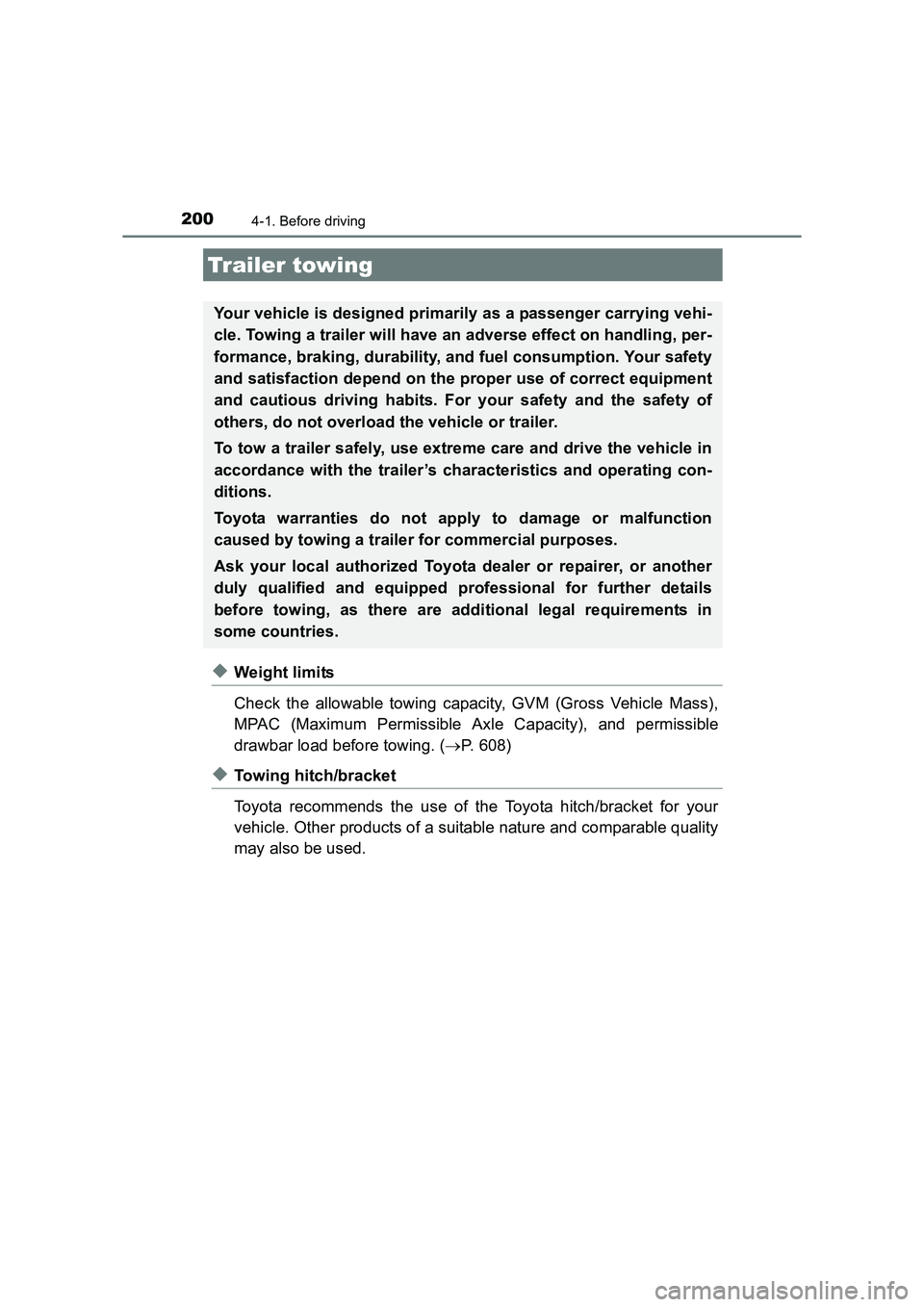
2004-1. Before driving
AURIS Touring Sports_EE (12K53E)
◆Weight limits
Check the allowable towing capacity, GVM (Gross Vehicle Mass),
MPAC (Maximum Permissible Axle Capacity), and permissible
drawbar load before towing. (→P. 608)
◆Towing hitch/bracket
Toyota recommends the use of the Toyota hitch/bracket for your
vehicle. Other products of a suitable nature and comparable quality
may also be used.
Trailer towing
Your vehicle is designed primarily as a passenger carrying vehi-
cle. Towing a trailer will have an adverse effect on handling, per-
formance, braking, durability, and fuel consumption. Your safety
and satisfaction depend on the proper use of correct equipment
and cautious driving habits. For your safety and the safety of
others, do not overload the vehicle or trailer.
To tow a trailer safely, use extreme care and drive the vehicle in
accordance with the trailer’s characteristics and operating con-
ditions.
Toyota warranties do not apply to damage or malfunction
caused by towing a trailer for commercial purposes.
Ask your local authorized Toyota dealer or repairer, or another
duly qualified and equipped professional for further details
before towing, as there are additional legal requirements in
some countries.
Page 201 of 660
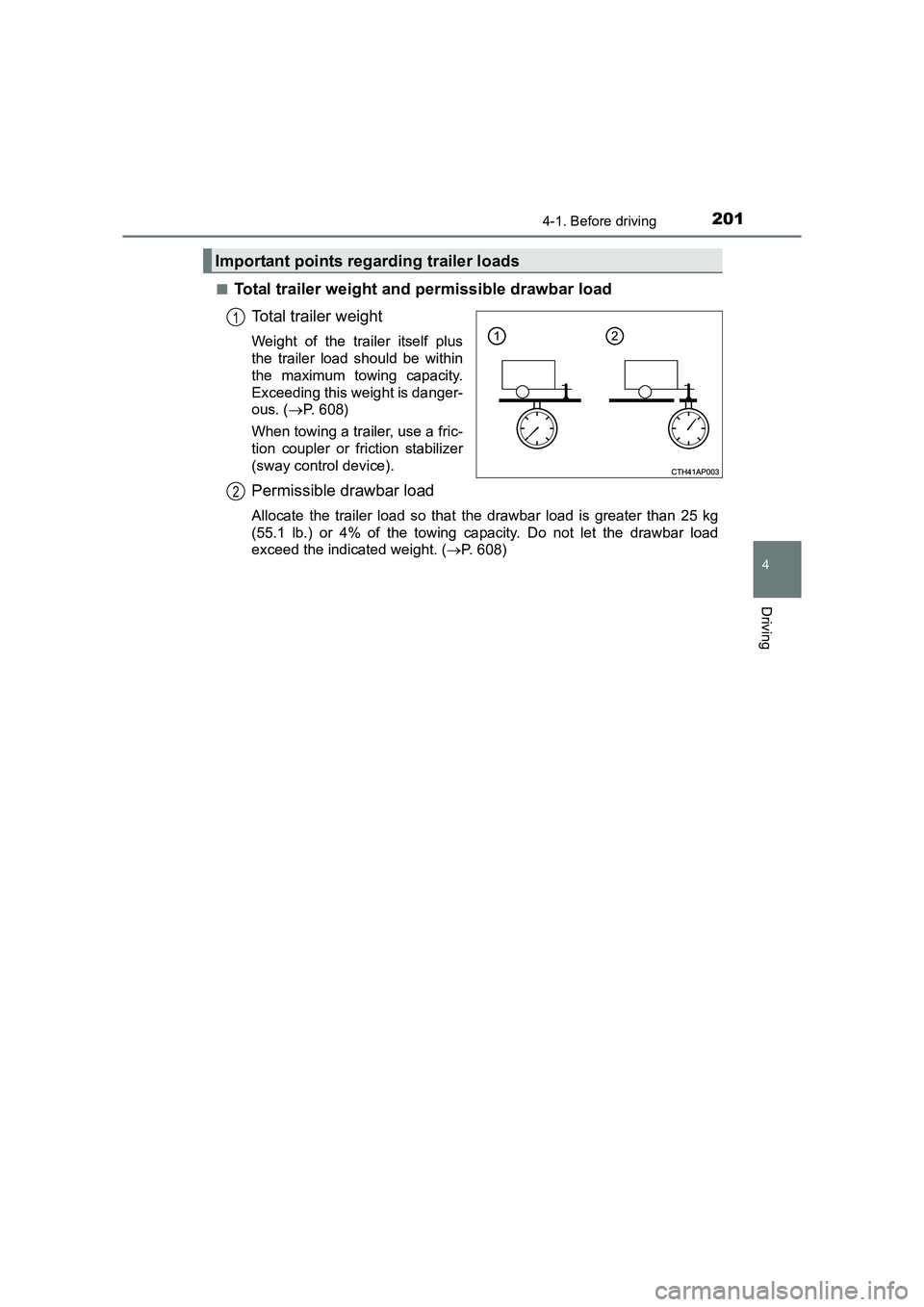
2014-1. Before driving
AURIS Touring Sports_EE (12K53E)
4
Driving
■Total trailer weight and permissible drawbar loadTotal trailer weight
Weight of the trailer itself plus
the trailer load should be within
the maximum towing capacity.
Exceeding this weight is danger-
ous. ( →P. 608)
When towing a trailer, use a fric-
tion coupler or friction stabilizer
(sway control device).
Permissible drawbar load
Allocate the trailer load so that the drawbar load is greater than 25 kg
(55.1 lb.) or 4% of the towing ca pacity. Do not let the drawbar load
exceed the indicated weight. ( →P. 608)
Important points regarding trailer loads
1
2
Page 202 of 660
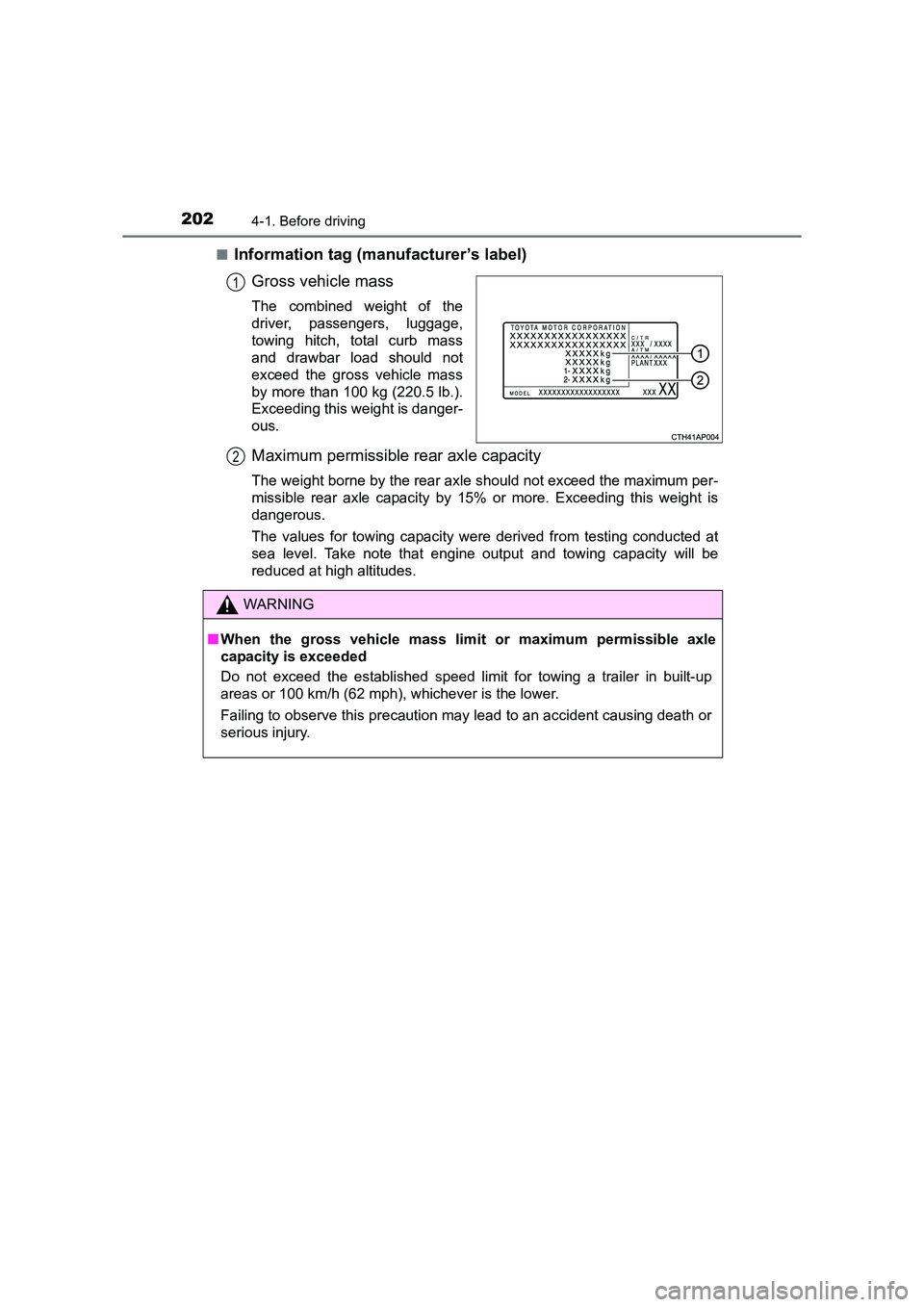
2024-1. Before driving
AURIS Touring Sports_EE (12K53E)■
Information tag (manufacturer’s label)
Gross vehicle mass
The combined weight of the
driver, passengers, luggage,
towing hitch, total curb mass
and drawbar load should not
exceed the gross vehicle mass
by more than 100 kg (220.5 lb.).
Exceeding this weight is danger-
ous.
Maximum permissible rear axle capacity
The weight borne by the rear axle should not exceed the maximum per-
missible rear axle capacity by 15% or more. Exceeding this weight is
dangerous.
The values for towing capacity were derived from testing conducted at
sea level. Take note that engine output and towing capacity will be
reduced at high altitudes.
1
WARNING
■ When the gross vehicle mass limit or maximum permissible axle
capacity is exceeded
Do not exceed the established speed limit for towing a trailer in built-up
areas or 100 km/h (62 mph), whichever is the lower.
Failing to observe this precaution may lead to an accident causing death or
serious injury.
2
Page 204 of 660
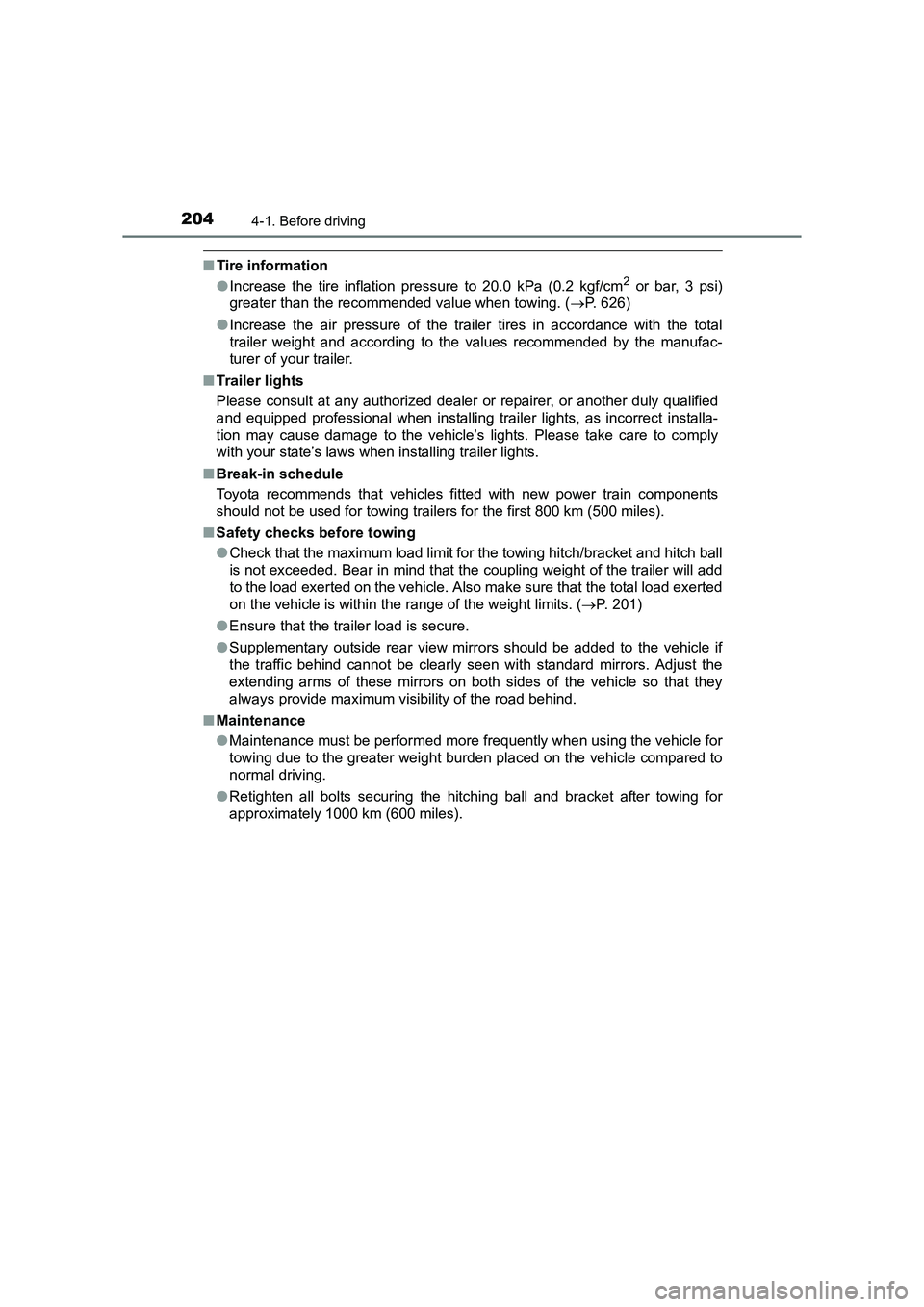
2044-1. Before driving
AURIS Touring Sports_EE (12K53E)
■Tire information
●Increase the tire inflation pressure to 20.0 kPa (0.2 kgf/cm2 or bar, 3 psi)
greater than the recommended value when towing. ( →P. 626)
● Increase the air pressure of the trailer tires in accordance with the total
trailer weight and according to the values recommended by the manufac-
turer of your trailer.
■ Tr a i l e r l i g h ts
Please consult at any authorized dealer or repairer, or another duly qualified
and equipped professional when installing trailer lights, as incorrect installa-
tion may cause damage to the vehicle’s lights. Please take care to comply
with your state’s laws when installing trailer lights.
■ Break-in schedule
Toyota recommends that vehicles fitted with new power train components
should not be used for towing trailers for the first 800 km (500 miles).
■ Safety checks before towing
●Check that the maximum load limit for the towing hitch/bracket and hitch ball
is not exceeded. Bear in mind that the coupling weight of the trailer will add
to the load exerted on the vehicle. Also make sure that the total load exerted
on the vehicle is within the range of the weight limits. ( →P. 201)
● Ensure that the trailer load is secure.
● Supplementary outside rear view mirrors should be added to the vehicle if
the traffic behind cannot be clearly seen with standard mirrors. Adjust the
extending arms of these mirrors on both sides of the vehicle so that they
always provide maximum visibility of the road behind.
■ Maintenance
●Maintenance must be performed more frequently when using the vehicle for
towing due to the greater weight burden placed on the vehicle compared to
normal driving.
● Retighten all bolts securing the hitching ball and bracket after towing for
approximately 1000 km (600 miles).
Page 206 of 660
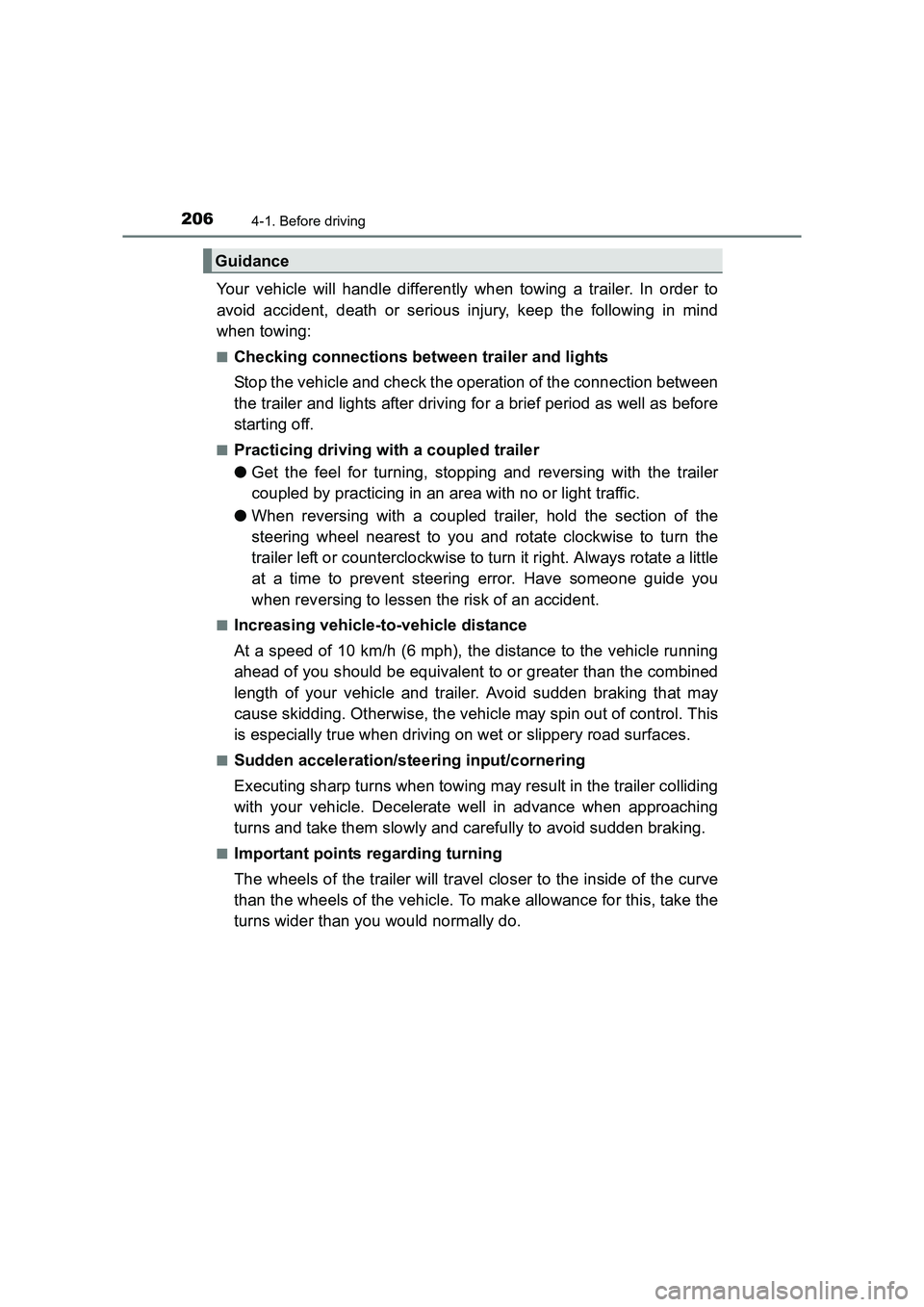
2064-1. Before driving
AURIS Touring Sports_EE (12K53E)
Your vehicle will handle differently when towing a trailer. In order to
avoid accident, death or serious injury, keep the following in mind
when towing:
■Checking connections between trailer and lights
Stop the vehicle and check the operation of the connection between
the trailer and lights after driving for a brief period as well as before
starting off.
■Practicing driving with a coupled trailer
●Get the feel for turning, stopping and reversing with the trailer
coupled by practicing in an area with no or light traffic.
● When reversing with a coupled trailer, hold the section of the
steering wheel nearest to you and rotate clockwise to turn the
trailer left or counterclockwise to turn it right. Always rotate a little
at a time to prevent steering error. Have someone guide you
when reversing to lessen the risk of an accident.
■Increasing vehicle-to-vehicle distance
At a speed of 10 km/h (6 mph), the distance to the vehicle running
ahead of you should be equivalent to or greater than the combined
length of your vehicle and trailer. Avoid sudden braking that may
cause skidding. Otherwise, the vehicle may spin out of control. This
is especially true when driving on wet or slippery road surfaces.
■Sudden acceleration/steering input/cornering
Executing sharp turns when towing may result in the trailer colliding
with your vehicle. Decelerate well in advance when approaching
turns and take them slowly and carefully to avoid sudden braking.
■Important points regarding turning
The wheels of the trailer will travel closer to the inside of the curve
than the wheels of the vehicle. To make allowance for this, take the
turns wider than you would normally do.
Guidance